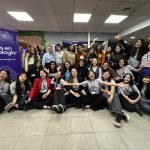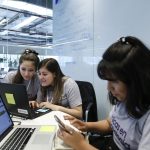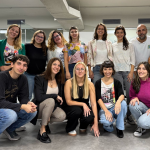“My dream is that what I do improves someone’s quality of life”
Victoria Peterson, one of the Argentine Women in STEAM, talks about how young women from the country can take part in interdisciplinary teams and create solutions that have a positive impact on society.
Text: Julieta La Casa
Being a woman, an Argentinian, a scientist, and a leader of projects that improve people’s quality of life, is it a possible combination? Sure it is. That reality is within the reach of girls and young and adult women who want to head toward the world of research, collaborative work, and the creation of solutions with social impact. This itinerary was walked through by Bioengineer and Doctor in Engineering* Victoria Peterson, who pursues further academic and professional training and testifies to the multiple journeys that Argentine science enables. “I always worked in the field of applied artificial intelligence (AI) for brain activity decoding. Through computer interfaces, we turn brain activity into control or communication commands from AI,” Victoria says.
According to data gathered by Chicas en Tecnología, in Argentine university degrees linked to Engineering and Computer Science, women account for less than 25% of the students while they are over 45% in the rest of the degree groups. Several studies, such as the ”A Power with Barriers” research conducted by the organization along with IDB’s INTAL, show that the lack of female role models is one of the barriers to accessing these disciplines. To transform this context, Victoria decided to participate in the Argentine Women in STEAM microsite, which boosts the voice of female creators in science and technology so that their experiences encourage more girls and women to be the protagonists of diverse teams and more inclusive societies.
What were your main goals as a student and engineer?
My main goal was to help improve people’s quality of life. My brother was born with hearing loss, so I understand the potential that medical devices have when it comes to improving someone’s quality of life because I saw it firsthand. What was clear to me is that I wanted to do something that helped society somehow, I did not know what yet. Then you find related subjects and that thing that you feel comfortable with, that makes you want to learn more. My dream is that what I do improves someone’s quality of life.
What would you like to share about your experience in the bioengineering degree?
As a bioengineer, I studied a lot about biology, mathematics, and electronics. I have always been a hard science person. Even though I liked drawing and I love decorating, I used to be a fan of mathematics and physics back in school. I chose that degree because I liked the subjects and I would do it again. We learn a lot about many topics and that makes us incredibly versatile. I chose to work on one of the thousands of possibilities that bioengineering offers. We have a lot of basic training that allows for exploration; that is what I like the most. Being an engineer is a lifestyle. Research is one’s nature. We are very methodical people with a particular way of seeing the world. I noticed that because, after six years in the same degree program, with the same language and the same people, when I got my degree, I got to know a different world, which is the Ph.D. You would find bioengineers, systems engineers, computer scientists, and mathematicians there, and the way that two people looked at the same thing from a totally different point of view was very interesting. It was clear that our profiles led the decision-making process on that issue that we had to solve for the class, for example. I would have never thought about those other paths and that is the nicest thing about these environments.
What does diversity contribute to your discipline?
Diversity adds flavor to everything. Any kind of diversity: ethnic, gender… Just as I looked at something in a way and the mathematician looked at it in a different way, that diversity, which is also related to discipline, is an example of how something can be boosted and is always improved with the introduction of different groups. Having a diverse population working together is going to boost all of those groups’ strengths because we all have different strengths. Otherwise, we would be addressing a problem or giving a solution with only one perspective because it was thought, for example, by men and it is going to be solved or better acquired for that group. Currently, we have a Justice Analysis in Artificial Intelligence group because we are interested in those topics, in talking about diversity from the inside so that the creation of the algorithms we generate or implement are fair too when brought to society. In very general terms, what we are looking for is that the algorithm does no harm and does not discriminate on the basis of ethnicity, race, or gender. We want it to be capable of doing its task; for example, detecting a lung disease from an image, regardless of the person’s sex or race. That is a fair or balanced algorithm from the point of view of the demographic information of the population to whom that detection service is provided. The thing with algorithms is that they evidence or boost what society already is because they are built from databases acquired by people. Artificial intelligence replicates sexist and racial biases because they are inherited. And it boosts them much more because it can do so faster or more evidently.
How was it to start an engineering degree where women are usually a minority?
I never cared about whether there were many or few women. Bioengineering has a great balance. When I started, we were 20 women out of 100 students; now we could say there are 40/60. I never felt like that space was not mine. There were never men on one side and women on the other side. It was a mixed thing. I also had female and male professors. But when I started the Ph.D., I was the only woman in the entire institute and that was hard. It was harder than I thought. Nowadays, talking about artificial intelligence is more in style. In the past, when I chose this profession at 22 years old, most of my female classmates decided to do sales or training or to go to Buenos Aires and the large cities. But there is a reason why we did not choose this and it is because there are no female role models. The women who taught the classes did not do machine learning but other things or they worked on the clinical area.
What do you think should be the characteristics of a technology leader?
You should have a lot of desire because this can be very hard at times. This activity has many moments of frustration. Most of the time, we are told “no,” “rejected,” “this is wrong, “this does not work,” “it is broken.” So you should have a high tolerance to frustration and an ability to get up, be resilient, and think, “What did I do wrong?” and try again. And what feeds that desire is the fact that you are doing what you want, so the main engine every day should be your desire, your research, what you are carrying out. You have to be passionate. People think we cannot build a family when we are scientists because there is not enough time. Writing a thesis is like raising a child because you dedicate the entire day, weekends, and holidays to it. It is true, I will not deny it, but we can be organized, go to the gym, eat healthy, cook, and also have children. You can do it and it is because of your desire. I am not that smart, there are lots of people smarter than me, but my desire is so big! It is also important to have good mentors, whether it is your director or a classmate because we need favorable growth environments.
What can the women who work on STEAM disciplines do to make more girls consider these degrees as valid and accessible options for them?
Women in science can give talks at universities to show that we are people with a personal life too. We should tell them that our job is to do science in the best way we can, that it is something real that we do from our passion while discovering and making many mistakes. The women who work in these disciplines can share their stories, what motivated them, and where and how they found their space. To me, it is important to show that we are regular human beings that meet with friends on the weekends, just like everyone else. We are not nerds shut away in white gowns, as the cartoons show. I like clothes, I do my make-up, and we need to cut the stereotypes. I wish there were trans people working on science because I honestly think there are not. It is not about the way you dress or the way you are but about you doing what you love. It is also important to show that there are possibilities because many people do not know the ways in which we can do science in Argentina. Our job is very collaborative and it highly depends on how you relate with others. That generates inspiration and possibilities. I have been in Switzerland for six months because I got a Ph.D. exchange scholarship. I never applied to major congresses because I considered them unaffordable, but there are scholarships for this. And diversity is currently getting more important in many aspects of these disciplines and there are scholarships for women and other minorities who work on machine learning. Those from us who do not have the financial ability to participate in those congresses can go with a scholarship. That is something ignored too and it is important to communicate that it is possible. It is not like you cannot participate because you are Latin American or a woman.
* Victoria Peterson
Bioengineering (Universidad Nacional de Entre Ríos [National University of Entre Ríos], 2013) and Doctor in Engineering. She took her Ph.D. studies at the Instituto de Señales, Sistemas e Inteligencia Computacional (Research Institute for Signals, Systems, and Computational Intelligence, sinc(i)-UNL-CONICET) thanks to a Ph.D. scholarship from CONICET. She joined the Instituto de Matemática Aplicada del Litoral (Litoral Institute of Applied Mathematics, IMAL-CONICET-UNL) in 2019. Currently, she holds a postdoctoral position at the Brain Modulation Lab, Massachusetts General Hospital, Harvard Medical School, Boston, USA. In 2021, she was appointed to join the CONICET’s Degree of Scientific and Technology Researcher as Assistant Researcher. Her research topics intersect artificial intelligence with bioengineering in the development of machine learning algorithms for decoding brain activity with medical applications.






